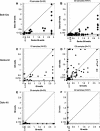Evaluation and comparison of two commercial enzyme-linked immunosorbent assay kits for detection of antigenically diverse human noroviruses in stool samples
- PMID: 15184438
- PMCID: PMC427881
- DOI: 10.1128/JCM.42.6.2587-2595.2004
Evaluation and comparison of two commercial enzyme-linked immunosorbent assay kits for detection of antigenically diverse human noroviruses in stool samples
Abstract
Two recently commercialized enzyme-linked immunosorbent assay kits, the SRSV(II)-AD (Denka Seiken Co. Ltd., Tokyo, Japan) and IDEIA NLV (DakoCytomation Ltd., Ely, United Kingdom) kits, that detect human norovirus (HuNV) antigens in stool samples were evaluated to assess whether they could be used instead of reverse transcription-PCR (RT-PCR) for routine diagnosis. The sensitivities and specificities of the two kits were tested with a panel of 103 stool samples containing HuNVs of 4 and 10 genetic subgroups within genogroups I and II (GI and GII), respectively, and 39 stool samples containing other enteric viruses. The Denka kit had a high sensitivity (>70% for 10 of the 14 subgroups) but a specificity of only 69%, and the Dako kit had a low sensitivity (<30% for 6 GII subgroups) but a high specificity of 100%. Statistical analysis suggests that HuNVs of four subgroups (subgroups GII/2, GII/5, GII/6, and GII/n) are likely to elude detection by the Dako kit. The two kits also demonstrated differences in reactivities. While the Dako kit discriminated between the GI and GII antigens of HuNVs, the Denka kit cross-reacted with samples containing all GI and GII subgroups of HuNVs. Moreover, the Denka kit also reacted with samples containing human sapovirus (HuSV). We demonstrate that the cross-reactivity of the Denka kit is not due to specific reactions with HuNV and HuSV antigens. These results indicate that neither the Denka kit nor the Dako kit has all the performance characteristics required to replace the RT-PCR methods used to detect HuNVs.
Figures




References
-
- Altman D. G. 1991. Practical statistics for medical research. Chapman & Hall, London, United Kingdom.
-
- Anderson, A., A. G. Heryford, J. P. Sarisky, C. Higgins, S. S. Monroe, R. S. Beard, C. M. Newport, J. L. Cashdollar, G. S. Fout, D. E. Robbins, S. A. Seys, K. J. Musgrave, C. Medus, J. Vinje, J. S. Bresee, H. M. Mainzer, and R. I. Glass. 2003. A waterborne outbreak of Norwalk-like virus among snowmobilers—Wyoming, 2001. J. Infect. Dis. 187:303-306. - PubMed
-
- Ando, T., J. S. Noel, and R. L. Fankhauser. 2000. Genetic classification of “Norwalk-like viruses.” J. Infect. Dis. 181(Suppl. 2):S336-S348. - PubMed
Publication types
MeSH terms
Substances
LinkOut - more resources
Full Text Sources
Other Literature Sources
Medical

